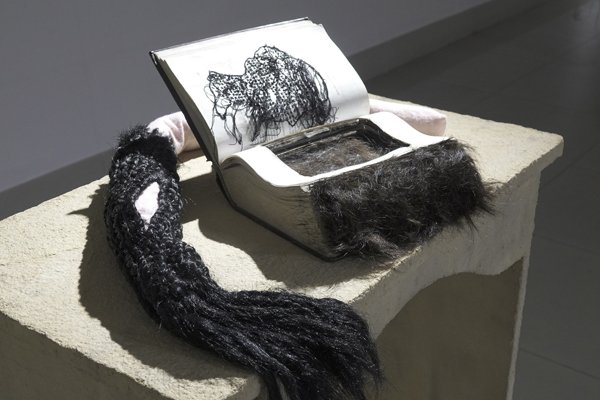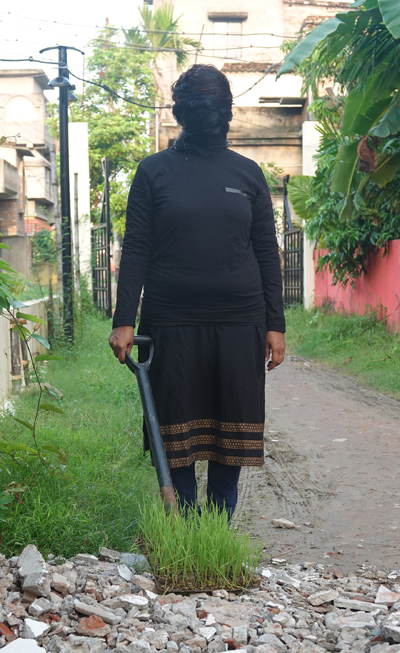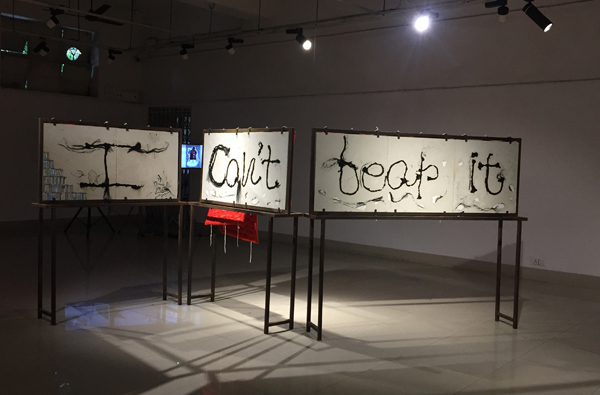Interview with Mallika Das Sutar
Colette Copeland
November 2023
 Where is the Equality, 2019, law book, hair and soft toy cloth
Where is the Equality, 2019, law book, hair and soft toy cloth
I recently met Mallika Das Sutar at the artist collective Chander Haat located outside of Kolkata, where she and her family live. In my mind, Chander Haat is an artist utopia, surrounded by lush tropical foliage and spacious art studios. In reality, it takes tremendous dedication as well as money to maintain a collective that functions outside of the mainstream art world. Its mission is to provide a space that inspires freedom without barriers, encouraging interdisciplinary research, creative experimentation and a commitment to community engagement.
My visit coincided with the late start of monsoon season, as well as Durga Puja—the largest contemporary public art event in the world. Many Chander Haat artists have been busy working for months on the large-scale Puja art installations in preparation for the festival that began on October 19th.
During the pandemic, I conducted a series of interviews with artist couples about their shifting art practices and coping strategies during the lockdown. Mallika Das Sutar and Bhabotosh Sutar’s interview ran in May 2020.
This interview culminates two days of conversations about art, life and social injustices against women.
Colette Copeland: I can’t believe it’s been three years since our interview. In that time, so much has changed, yet life continues. One question you posed during our 2020 interview was, Faced with this crisis, I wonder what will happen to our artistic expressions? That is a good place to start our conversation. How has your artistic practice and expression evolved over the last 3 years and what life lessons emerged from the pandemic?
Mallika Das Sutar: Since the pandemic, my subject matter and process has dramatically changed. My earlier work focused on gender identity and gender violence. As a female artist, I have always been inspired by what I have seen and experienced, as well as exploring those hidden stories and narratives masked by perpetual violence.
After the pandemic, my personal reflections expanded from the female body to encompass a larger perspective addressing issues surrounding the ecological realities of our times and how humans’ disruptive patterns affect ecological harmony.
My concerns revolve around analyzing ways of life through a restorative, transformative and regenerative lens. To create more community-driven work that grounds us towards the geography and ecology of the surrounding landscape, as well as emphasizing local and cultural history and wisdom through the perspective of self-sufficiency. As an artist, it is important for me to work as a catalyst towards affecting change in the community.
During the lockdown, I had the opportunity to engage deeply with my community. I interacted directly with the neighborhood adults and children, discovering the collective desire to come together to share knowledge about nature and non-dominant, cultural, micro-histories. For me the value of art is in finding and creating a sense of hope along with my community.
My neighborhood’s ecological and demographic history as well as the community women are an important concern for me as a functioning artist in these times. Sarsuna lies South-East of the burgeoning Kolkata, an erstwhile wetland area that has slowly been converted into human settlements. A neighborhood constructed on wetlands has many ecological issues including monsoon flooding, plastic and sewage waste. The area once crowded by the influx of refugees from a war-torn East Bengal is now home for many migrant communities. I have written about my interventions as “TALES FROM SARSUNA”.
CC: My research centers around artists’ works addressing themes about borders and boundaries. In your performance work, you use the body as a metaphor for the limitations and boundaries of female existence. I am thinking of your works, The Mud & the Body” (the hope and despair) as well as the Untitled performance made during the pandemic, where you wrapped your hair around your face like a shroud. Your work also focuses on the environment and climate change, especially as it affects local farmers and their economy. How does your personal and collaborative work explore these themes including physical, emotional, symbolic and geographic boundaries?
 from Untitled Performance, 2020
from Untitled Performance, 2020
MDS: An interesting part of my journey as a performance artist, especially when I perform in my community, has been a subconscious effort of crossing many barriers of identity. I moved to Chander Haat after my marriage. People here think of me as a daughter-in-law. So as an artist when I perform elsewhere, I don’t have such identities affecting my work. When I am working directly in my place of residence and in the extended community, the work expands the social and political boundaries of this neighborhood.
The community women (with whom I regularly collaborate) and I work together to create a floating, fluid space. In 2016, I chose to work with the women in the Manasa Mandir (local temple). I heard them sing ballads honoring the goddesses. My queries and conversations reinforced the notion of the absence of unique, individualized identity as they are only recognized as someone’s mother or daughter or wife.
Our closeness was often frowned upon by the men in the community, who did not understand my agenda. They perhaps mistakenly interpreted my intentions as profiting from the women, since international artists often visit this place. But for us women, it was a completely different experience; it brought us closer in understanding. Although they do not identify as artists, we can communicate our feelings and concerns to create work together. We farm, harvest wild greens, grow mushrooms, preserve seeds and “perform” when we need to communicate something more significant.
When we walk across the canal or the pond looking for edible weeds or identifying wild plants, I often hear stories from the women about their childhoods. Memories of walking around green patches of land, playing in clean blue ponds and foraging wilds as their grandmothers taught them. My intentions are to gather lived experiences as a source of alternative knowledge in the form of memories and stories. And to preserve these oral histories.
The two works you mention embody conversations around our tendencies to continuously dissect, amputate and isolate our environment, history, community, identity and the body, that is the carrier and presenter of all these man-made realities. The Untitled performance occurred during the time when the farmers’ protest escalated in the capital of the country. The farmers continuously struggle to farm the barren land, which does not provide enough to feed their families. I covered my face with my hair to show that these struggles are faceless. It doesn’t matter who I am, this reality is larger than me.
In my work The Mud and the Body, I too demonstrate the multiple gazes of powerful dissections upon our body. The patriarchal story of objectification, the capitalist story of exploitation and the historic tragedy of divide, partition and separation while we slowly begin to submerge ourselves into the rising sea levels and impending climate crisis.
CC: Your current work with the clay female forms embedded with seeds converges the recurrent themes of violence against women and indigenous farming practices, as well as celebrating mother earth and female power. Please explain about the new work and the focus of your upcoming exhibition in Delhi.
MDS: My Delhi exhibition is a multimedia installation piece that magnifies the invisible link between our cultural food practices and ecology. What we eat, what we cultivate and how we share. How do we intervene and transform the dominant practices of agricultural systems that do not look at food, soil and the entire ecology from a resilient and regenerative perspective? What do we think today when we cook our daily staples? Do we register the stories of loss that are silently displayed on our dinner plates?
The work is inspired by Poncho Byenjon— a Bengali traditional meal cooked by the women for their families and special guests. The phrase translates into five different recipes. These recipes have a specific ascending order of tastes beginning from something bitter and ending with something sour and sweet. The hollow clay figures represent tiny goddess sculptures and are arranged on a serving platter with kantha stitch motifs. Embedded in each idol are seeds for plants that would be required to cook an ideal poncho byenjon meal. The work comes together in collaboration with farmer and seed preservationist Tapan Adhikari and Ethnomusicologist Chandra Sen.
Chandra Mkhopadhyay has archived songs composed by women from various communities as they farmed and cooked together. These songs beautifully narrate their relationship with the seasonality of farming, harvesting and cooking that the women engaged in agricultural societies.
The sculptures symbolize private rituals. Goddess Lakhi with the vagina is the one who is the goddess of prosperity. Amongst the many forms of torture that are enacted upon women, the act of hiding the violence and burying it is prevalent. The female nude body is seen as shameful.
After the exhibition, I will bury the sculptures into the ground, so that the seeds can grow. If the sculptures find a place in the gallery’s garden, perhaps it will turn into a tiny seed bed.
CC: Let’s back up and discuss your pre-pandemic 2019 exhibition, There Is Nothing Natural or Inevitable About Violence Against Women. You spent a year researching and collaborating with NGOs and then a year of production leading up to this exhibition. The works included a variety of media including sculpture, sound, video and installation. Hair is a recurring medium throughout many of the works. What is the significance of hair as it relates to violence against women, as well as a signifier of gender and beauty in Bengali culture?
MDS: Four works in the solo exhibition had hair as a primary tool of expression. My hair is like a weapon that I use to express my inner angst, as well as demonstrate strength. I don’t see it as a marker of beauty. Often women’s hair is used by men as soft targets to perpetuate violence against them. They pull it, cut it and shame it. When a woman is declared to be a witch, especially in the villages, they cut their hair to “de-beautify” her. Hair is a metaphor of resistance.
The work I am not an object, examines the objectification and commodification that society offers to a woman. The work questions the perpetual violence and assault faced by women. Despite the laws, women still suffer. The work, the crown, addresses unequal work distribution, work pay and the invisibility of women’s labor. The work I can’t bear it, demonstrates physical and mental trauma surrounding our body.
CC: In one of our conversations you stated, As an artist, I always speak to truth. Without getting too philosophical about the meaning of truth in the age of fake news and social media, I have been thinking a lot about this statement as it relates to the ugly truths that people do not want to talk about. It takes a lot of courage to speak the truth and speak out against those in power. I mentioned that in preparation for my India trip, I read a lot of novels by Indian writers and one in particular—The Daughters of Madurai by Rajasree Variyar. I was shocked and saddened by the stark depiction of the killing of girl babies in rural villages. I asked you about this phenomenon, as well as victims of acid-throwing and elective abortions based on gender testing. Given the current politics, does speaking the truth about injustices against women garner criticism or controversy?
MDS: When I started my research-based work, I really didn’t think that I would get the opportunity to work with NGOs. When I interviewed organizations that work with sex workers and trafficking, I felt that my artistic practices finally connected with the practicalities of life around me. But in this process, I had also had to face certain hard truths regarding how organizations operate. The field of social and developmental work is business oriented with a financial bottom-line.
Focusing on gender issues as a female artist has limitations, since curators perceive your work within a limited framework. I do not accept invitations for group exhibitions showcasing women only artists, since this seems marginalizing on the part of the organizer.
My critics including many educated people argue that we cannot portray a complete story of violence against women only through the perspective of gender. As a woman and a female artist, I have lived experience in how to occupy space, and form independence in a world that has so meticulously assigned roles and restricted women from crossing certain boundaries. We still face discrimination as women and artists, especially the lack of equality in all realms. We have laws and rights but what happens when the law is not upheld? How do I implement them in the corners of shared domestic life?
As a female, I feel the violence, neglect and inequality women experience every day. We still don’t have significant systems to address these grievances and take action. I do not feel that I am in a safe position considering the insurmountable patriarchy surrounding me.
In my work I can’t bear it, the “I” does not just represent me or other Indian women. It refers to women from all over the world. I put maps of different countries inside homeopathy bottles symbolizing that this is a global reality. Women are in similar situations negotiating power dynamics. It is not just through education and literacy that we will be able to eliminate such mindsets. There is a need for a heightened humanity that sees us as equals.
 from I can’t bear it, exhibition plaster of paris, hair, medicine bottol, iron, cloth
from I can’t bear it, exhibition plaster of paris, hair, medicine bottol, iron, cloth
Colette Copeland 2020 interview with Mallika Das Sutar & Bhabotosh Sutar →
This is the third in a series of interviews Colette Copeland will be doing as part of her Fulbright Research Award to India. She’ll be researching and writing about female artists who are working with non-traditional materials and processes.
Colette Copeland is an interdisciplinary visual artist, arts educator, social activist and cultural critic/writer whose work examines issues surrounding gender, death and contemporary culture. Sourcing personal narratives and popular media, she utilizes video, photography, performance and sculptural installation to question societal roles and the pervasive influence of media, and technology on our communal enculturation.
To read Colette Copeland’s interview with Manjushree →
To read Copeland’s interview with Pooja Bahri →
Follow Colette Copeland in India →
